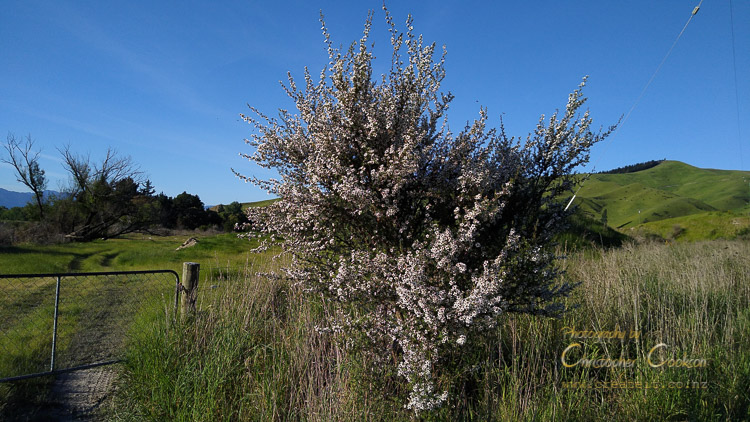Mānuka (Leptospermum scoparium)
Last Modified: 5-3-2021 11:22

Mānuka in flower in Taylor Pass Road
© Christopher Cookson License this image
Mānuka (Leptospermum scoparium) is a common New Zealand native shrub or small tree, also found in parts of Australia, producing a distinctive honey valued for medicinal properties. Wood is hard and dense with a reddish colour, while bark is grey and flakey, although fungus growing on the surface of wood can give a black appearance. Superficially, mānuka resembles kānuka, however mānuka has larger seed capsules, and the leaves are larger and more rigid having a prickly feel. Kānuka can grow to a large tree of up to 30 metres, whereas mānuka only reaches a maximum of 5 metres, and often remains a small shrub. Flowers are typically white, or pinkish-white, although dark pink flowering hybrids exist. Flowering can occur throughout the year.
Mānuka can be found throughout Marlborough from the Sounds to drier south Marlborough, with a variety of hybrids also grown as garden plants. Although capable of surviving in a variety of habitats, mānuka tends not to be found in dense forest, but more in open country, regenerating forest, riparian zones, and around forest margins. Until the discovery of antibacterial properties associated with mānuka honey, mānuka was often considered a weedy species, and it was widely cleared to make way for agriculture, however medicinal properties have resulted in interest in planting mānuka. Its resiliance and ease of propagation from seed makes it a useful pioneer species for native revegetation projects. Unfortunately from an economic perspective, although a considerable amount of honey is produced in Marlborough, mānuka in Marlborough generally does not have sufficient levels of the compounds and DNA markers to meet the legal definition of mānuka honey, even when collected from mānuka flowers.
Mānuka has a range of traditional uses with leaves used in various remedies, wood used for making implements, and bark sometimes used for roof cladding. Captain Cook used mānuka as a substitute for tea, and this use was continued by European settlers, resulting in the name 'tea tree' sometimes applied to mānuka.
This example was observed in Taylor Pass Road.
Image Date: 15/11/2020
Photographer: Christopher Cookson
Location: Latitude: -41.580147 Longitude: 173.934982